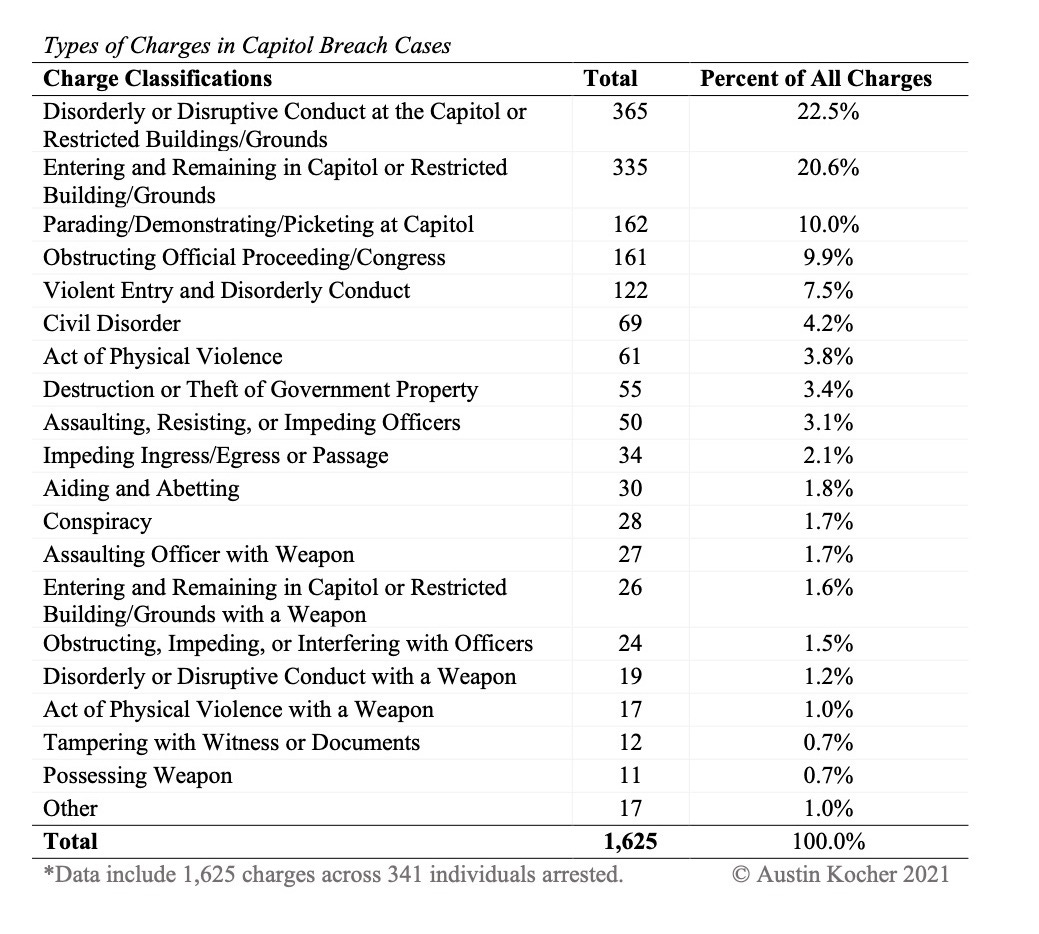I analyzed the data from 341 individuals charged in the Capitol Breach Cases from the insurrection on January 6, 2021. Here’s what I found.
The Department of Justice is currently investigating and prosecuting individuals involved in the insurrection at the Capitol on January 6, 2021, or what the U.S. Attorneys Office in the District of Columbia is calling the Capitol Breach Cases.
The U.S. Attorneys Office created a public webpage that lists case-by-case data related to “defendants charged in federal court in the District of Columbia related to crimes committed at the U.S. Capitol in Washington, D.C, on Wednesday, Jan. 6, 2021.” The data includes case numbers, first and last names, charges, relevant legal documents, location and date of arrests, and the date of the most recent case update.
On April 8, I downloaded and archived available data from the Capitol Breach Cases webpage and analyzed it. As of April 8, the U.S. Attorneys Office of D.C. listed a total of 341 individuals charged across 263 separate cases, with some cases including more than one defendant. Three individuals had not been assigned case numbers.
Where Did Arrests from the Capitol Breach Cases Take Place?
Out of the 341 individuals who were arrested so far, 294 included data about where their arrest took place. Arrests took place across 37 states, although ten states stood out with ten or more total arrests per state. I am including a table below with arrests in all states.
Charges in Capitol Breach Cases
I attempted to analyze the case-by-case charge data made public by the U.S. Attorneys Office. This proved challenging, because the U.S. Attorneys Office’s public data is plagued by data quality problems, specifically two types of issues: (1) frequent misspellings and (2) remarkably inconsistent descriptions of charges. In all but five charges, no federal statutory codes are provided that would allow for more precise analysis.
As a result, I adopted a textual analysis approach in analyzing the charges. This required two subjective decisions. First, because the charge descriptions were inconsistent and often lacked clarity regarding distinctions between different charges, where the text was clear, I segregated individual charges in order to approximate the total number of discrete charges per individual. Second, I grouped similar charges together for descriptive purposes. For instance, the U.S. Attorney Office lists 35 variations (including various wordings and misspellings) of “disorderly and disruptive conduct” that took place at what the Office describes variously as the Capitol, on restricted grounds, or inside restricted buildings. I grouped these charges under a single heading “Disorderly or Disruptive Conduct at the Capitol or Restricted Buildings/Grounds.”
In total, I identified 1,625 distinct charges across 341 defendants. On average, each person received 4.8 separate charges, with a median of 4 charges; 95 of the 341 defendants received four charges. Seven defendants received only one charge and one defendant received 11 charges. Most of the defendants — 60 percent — received three, four, or five charges.
With an estimated 365 mentions, the most common type of charge listed by the U.S. Attorney Office in Capitol Breach Cases involved a version of what I labeled as “Disorderly or Disruptive Conduct at the Capitol or Restricted Buildings/Grounds.” Second, with an estimated 335 mentions, was “Entering and Remaining in Capitol or Restricted Building/Grounds.” Third and fourth, respectively, were “Parading/Demonstrating/Picketing at Capitol” (162 mentions) and “Obstructing Official Proceeding/Congress” (161 mentions). In fifth place was “Violent Entry and Disorderly Conduct” with 122 mentions in the U.S. Attorney Office data.
For a complete listing of types of charges, see the table below. Note that due to my consolidation of U.S. Attorney Office data, a single defendant may have multiple charges under a single heading, or multiple charges across multiple headings.







